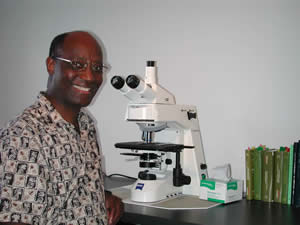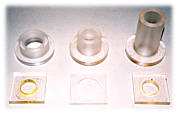|
|
|
Analyses (identification and
enumeration) of phytoplankton and periphyton samples are performed
using the traditional Utermö hl settling technique and an inverted
microscope equipped with phase contrast. Identifications are performed
at magnifications ranging between 165X and 750X.
|

|
|
Counting units are individual cells,
filaments or colonies depending on the organization of the algae. A
minimum of 400 - 500 units (usually at multiple magnifications) from
randomly selected transects are counted for each sample; counting at
multiple magnifications allows us to correctly enumerate taxa present
that may vary by several orders of magnitude in size. In cases where a
sample has extremely few algal units and high particulate matter (thus
yielding less than 400 units), as many transects as possible will be
covered in order to have more than 70% of the chamber counted; the
entire chamber is counted when possible.
|
 Identification of diatoms to species
level involves boiling/digesting sub-samples in hydrogen peroxide in
order to clean the frustules, followed by mounting on glass slides
using Naphrax and identification at 1000X magnification under oil
immersion. The diatoms identified on the mounted slides are matched
with what are obtained in the fresh samples; where it is not possible
to separate two or more species in the fresh samples, separation is
done by proportion. Identification of diatoms to species
level involves boiling/digesting sub-samples in hydrogen peroxide in
order to clean the frustules, followed by mounting on glass slides
using Naphrax and identification at 1000X magnification under oil
immersion. The diatoms identified on the mounted slides are matched
with what are obtained in the fresh samples; where it is not possible
to separate two or more species in the fresh samples, separation is
done by proportion.
|
|
Zooplankton is enumerated (from three
1-5 ml sub-samples) using a dissecting microscope at 41X-60X
magnifications for macrozooplankton; microzooplankton (rotifers and
copepod nauplii) are analysed following Utermöhl’s sedimentation
technique at 165X-375X magnifications on an inverted microscope.
Sub-sample volumes used depends on the density of organisms and the
amount of particulate matter in the sample.
|
|